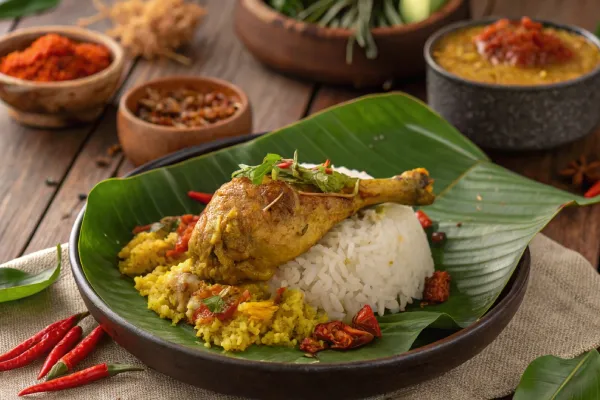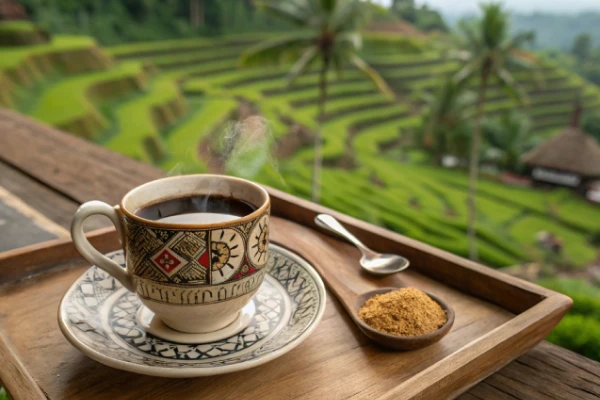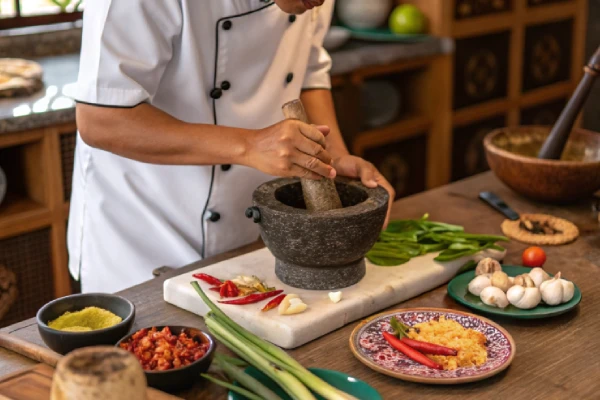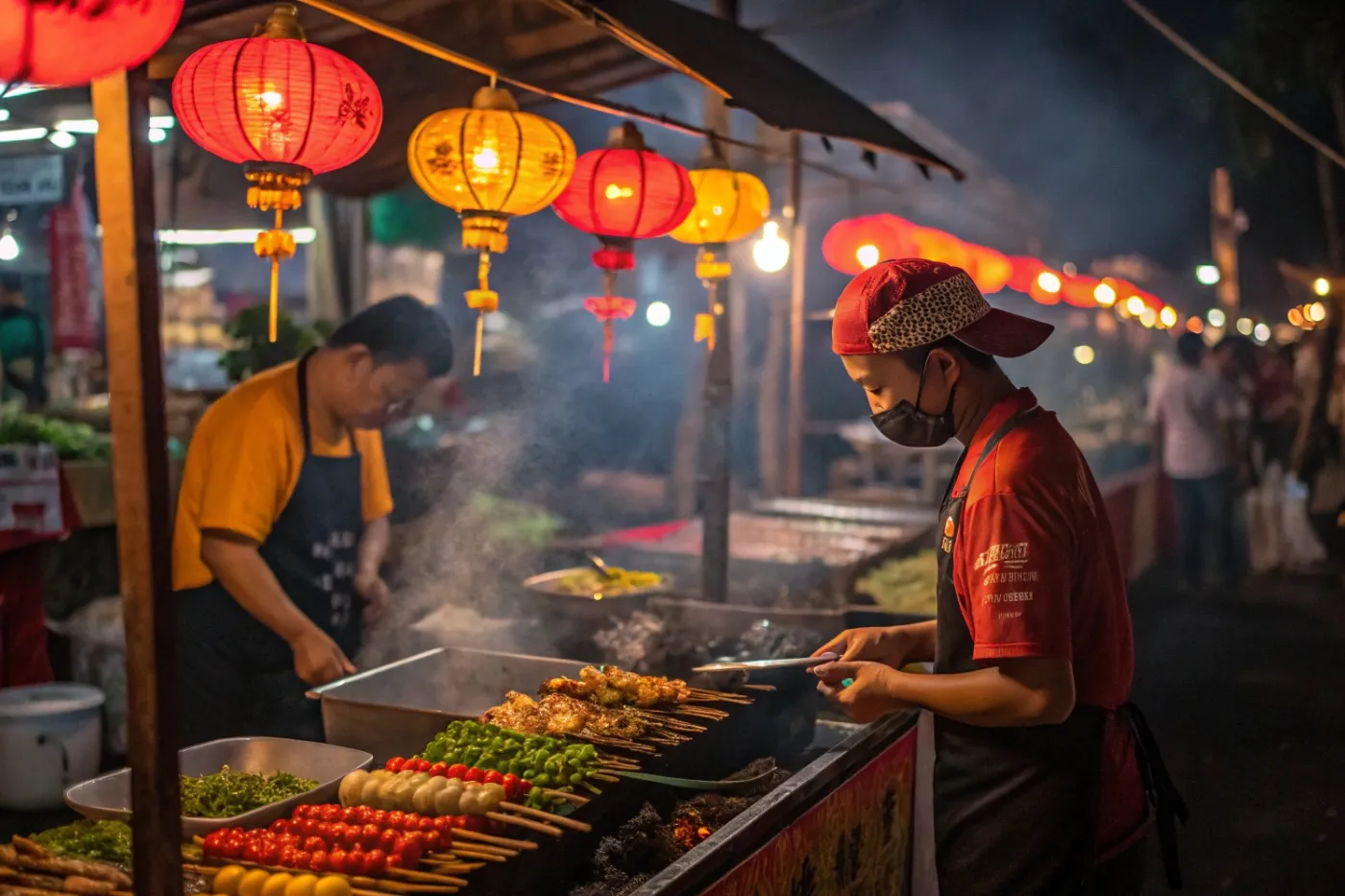Bali is a paradise not just because of its breathtaking beaches and lively culture but also because of its amazing food. My belief has always been that the most effective way to enjoy a place is to experience its food and Bali is no different. When I first visited Bali I erred by eating at popular restaurants, but then realized I was missing the real flavor in Balinese food. When I began eating in tiny local warungs (local restaurants) as well as food markets, my view changed completely.
In this guide, I’ll walk you through everything you need to know about how to Eat Like a Local in Bali—from must-try dishes to the best places to find authentic flavors. Get ready to embark on a delicious adventure!
Table Of Contents
Table of Contents
Why Eating Like a Local in Bali is a Must
The Significance of Food in Balinese Culture
The food In Bali can be more than the need for food, it is deeply rooted in spirituality, tradition, and community. Each meal reflects Bali’s Hindu tradition, with rituals made to gods before eating. Traditional dishes are prepared with traditional techniques and fresh, local ingredients which makes Balinese cuisine delicious and significant to the culture.
Local vs. Tourist Food – What’s the Difference?
Many restaurants cater to tourists with Westernized versions of Balinese dishes, often lacking the depth of flavor found in authentic local eateries. To truly experience Balinese cuisine, seek out warungs—small, family-run eateries serving traditional food—or visit bustling local markets. Eating at these places provides a more authentic taste of Bali and supports local businesses.
The Best Traditional Balinese Dishes to Try

Nasi Campur – Bali’s Ultimate Mixed Rice Dish
Nasi Campur, meaning “mixed rice,” is a must-try dish in Bali. It consists of steamed rice served with small portions of vegetables, meats, tempeh, sambal, and other flavorful side dishes. Every warung has its variation, making each experience unique.
Babi Guling – The Famous Suckling Pig
Babi Guling is one of Bali’s most celebrated dishes. This slow-roasted suckling pig is seasoned with turmeric and a blend of local spices, and then cooked over an open flame until crispy and golden. Traditionally served with rice, spicy sambal, and vegetables, it’s a dish best enjoyed at a well-known warung specializing in pork.
Ayam Betutu – Spiced Slow-Cooked Chicken
Ayam Betutu is a fragrant, slow-cooked chicken dish wrapped in banana leaves and infused with a rich blend of Balinese spices. It’s often prepared for religious ceremonies and special occasions. The slow-cooking process allows the flavors to develop, resulting in a tender and aromatic meal.
Lawar – Traditional Minced Meat & Veggie Dish
Lawar is a flavorful dish made from minced meat, grated coconut, vegetables, and a mix of Balinese spices. Some versions include fresh blood for added depth of flavor, but vegetarian options are also available. It’s a common side dish served with rice and meats.
Bebek Betutu – Slow-Roasted Duck
Similar to Ayam Betutu, Bebek Betutu features duck instead of chicken, slow-roasted with Balinese spices. The meat is incredibly tender, falling off the bone, and bursting with flavor. It’s often served as a festive dish during ceremonies and celebrations.
Where to Find the Best Local Warungs and Street Food
What is a Warung?
A warung is a small, family-run eatery that serves authentic, home-cooked Balinese food. These spots offer affordable and flavorful meals, often prepared using traditional cooking techniques passed down through generations. Eating at a warung is one of the best ways to experience real Balinese cuisine. Looking for inspiration? Try these beach picnic recipes to bring Bali’s flavors to your seaside gatherings.”
Top Warungs for Authentic Balinese Cuisine
- Mek Juwel – Famous for its delicious nasi ayam (chicken rice) with a variety of flavorful side dishes.
- Babi Guling Pan Ana – A go-to spot for crispy, spice-infused suckling pig.
- Dapur Bali Mula – Known for its traditional, fire-cooked dishes using only local ingredients.
The Best Night Markets for Local Street Food
For a true street food experience, visit Bali’s night markets, where locals gather to enjoy cheap and tasty eats. Some of the best include:
- Gianyar Night Market – A paradise for satay, babi guling, and local desserts.
- Sanur Night Market – A great place to try martabak (stuffed pancakes) and bakso (meatball soup).
- Kreneng Night Market – Popular for its wide variety of local dishes at bargain prices.
The Art of Balinese Food Markets
Morning vs. Night Markets – What to Expect
Balinese markets are the center of the local food scene. The morning markets are the place where locals can buy fresh and healthy ingredients such as fruits and vegetables as well as spices. They also sell traditional breakfast options like bubur injin (black rice pudding) and Nasi jinggo (small rice packs containing spicy sides).
In evening markets the main focus is on street food. Stalls are filled with satay that is hot with fried bananas, and boiling bowls of Bakso (meatball soup). These vibrant markets are worth a visit to get a real flavor of Bali.
Best Markets for Fresh Ingredients & Local Snacks
- Badung Market (Denpasar) – The largest market, perfect for fresh produce and Balinese spices.
- Ubud Market – A great place to find local fruits, coffee, and Balinese cooking essentials.
- Gianyar Night Market – A food lover’s paradise with a variety of cheap, delicious street food.
Must-Visit Local Eateries in Bali
Dapur Bali Mula – Traditional Cooking Over Fire
Located in North Bali, this warung specializes in ancient cooking techniques, using a clay stove and open fire to prepare dishes like wood-smoked chicken and fish wrapped in banana leaves.
Mek Juwel – The Best Nasi Ayam
A family-run warung is famous for its nasi ayam (chicken rice), which comes with shredded chicken, sambal, peanuts, and a flavorful broth.
Babi Guling Pan Ana – Famous Suckling Pig Spot
Known for its crispy-skinned babi guling, this place in Denpasar serves one of the best versions of Bali’s famous roasted pig.
Warung Lesehan Merta Sari – Grilled Tuna Satay
A hidden gem on Bali’s northeast coast, this warung specializes in sate lilit, a type of fish satay minced with Balinese spices and grilled over coconut charcoal.
Fu Shou Noodle Club – Handmade Noodles in Ubud
A casual eatery serving handmade bakmie noodles, dumplings, and Hainanese chicken rice, all prepared from scratch.
Balinese Drinks – What to Sip Like a Local

Bali Coffee – Kopi Bali & Luwak Coffee
Balinese coffee culture is rich, with kopi Bali being a strong, unfiltered brew made using traditional methods. Luwak coffee, one of the world’s most expensive coffees, is made from beans that have been digested by civets before roasting.
Arak – Bali’s Traditional Rice Liquor
Arak is a locally made spirit distilled from rice or palm sap. Some warungs serve homemade arak infused with herbs or fruit, making it a unique local drink.
Es Daluman – Traditional Grass Jelly Drink
A refreshing, slightly sweet drink made from daluman leaves, mixed with coconut milk and palm sugar. It’s a popular choice for cooling down in Bali’s tropical heat.
A visit to Bali isn’t complete without trying Arak, the island’s traditional rice liquor, or enjoying a tropical cocktail by the beach. Discover great ideas like these refreshing beach cocktails that pair perfectly with local Balinese dishes
The Role of Religion and Rituals in Balinese Food
Ceremonial Dishes & Offerings in Bali
Balinese Hinduism plays a significant role in food culture. Many dishes, such as lawar and babi guling, are prepared for ceremonies and temple offerings. These foods symbolize gratitude and are often shared with the community.
How Hinduism Shapes the Culinary Landscape
The beliefs of the island’s religious leaders affect the diet that is vegetarian Certain days are devoted to eating plant-based or fasting meals. Local markets usually sell food items for ceremonies which makes it simple to taste the sacred aspects of Balinese food.
Cooking Like a Local – Best Cooking Classes in Bali

Cooking Balinese food yourself can be a rewarding experience, especially when using fresh, local ingredients. Don’t miss our guide to the best beaches in Southeast Asia—perfect for finding fresh seafood markets along the coast
Why Take a Balinese Cooking Class?
Learning to cook Balinese food is a hands-on way to understand the island’s unique flavors. Classes often include market tours, allowing visitors to pick fresh ingredients before cooking traditional dishes.
Best Cooking Classes for Tourists
- Paon Bali Cooking Class (Ubud) – One of the most famous cooking experiences, featuring a market visit and hands-on lessons.
- Bumbu Bali Cooking School (Nusa Dua) – Run by a Balinese chef, this class teaches authentic techniques using local spices.
- Balinese Farm Cooking School (Sidemen) – Set in the countryside, this class focuses on traditional farming and cooking methods.
Tips for Eating Local in Bali Safely
How to Avoid Bali Belly
Bali Belly (traveler’s diarrhea) is common among visitors. To avoid it:
- Eat at busy warungs where food is freshly cooked.
- Stick to bottled or filtered water.
- Avoid raw salads or unpeeled fruits unless you wash them yourself.
Food Safety Tips for Travelers
- Choose stalls where locals eat – this indicates fresh, high-turnover food.
- Carry charcoal tablets or probiotics – these help with digestion.
- Avoid ice in drinks unless from a trusted source – some places use unfiltered water for ice.
FAQs – About How to Eat Like a Local in Bali
Is Balinese food spicy?
Yes, many dishes use sambal (spicy chili paste), but you can request milder versions at most warungs.
Are there good vegetarian options in Bali?
Absolutely! Many dishes, such as gado-gado (vegetable salad with peanut sauce) and tempeh-based meals, are vegetarian-friendly.
Can you drink tap water in Bali?
No, it’s best to drink bottled or filtered water to avoid contamination.
What’s the best time to visit food markets?
Morning markets are great for fresh produce, while night markets offer the best street food experience.
How much does it cost to eat like a local?
Eating at a warung can cost as little as $2-$5 per meal, making it an affordable way to enjoy Balinese cuisine.
Conclusion
Eating like a local in Bali is an unforgettable experience that goes far beyond simply tasting food. It’s about experiencing the rich culture of Bali as well as its traditions and spirit. If you’re eating the taste of Nasi Campur at a local warung and sipping the kopi Bali or wandering through the bustling night markets each meal tells the story. So, leave those touristy traps, and sink into the authentic tastes of Bali. Taste buds (and your pocket) will be thankful!


